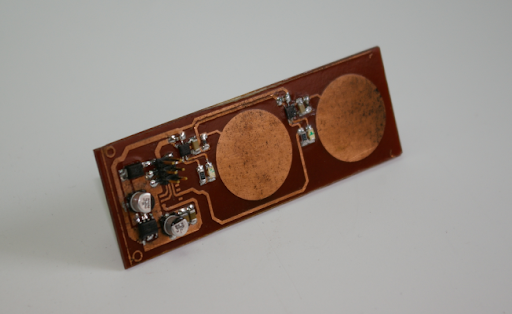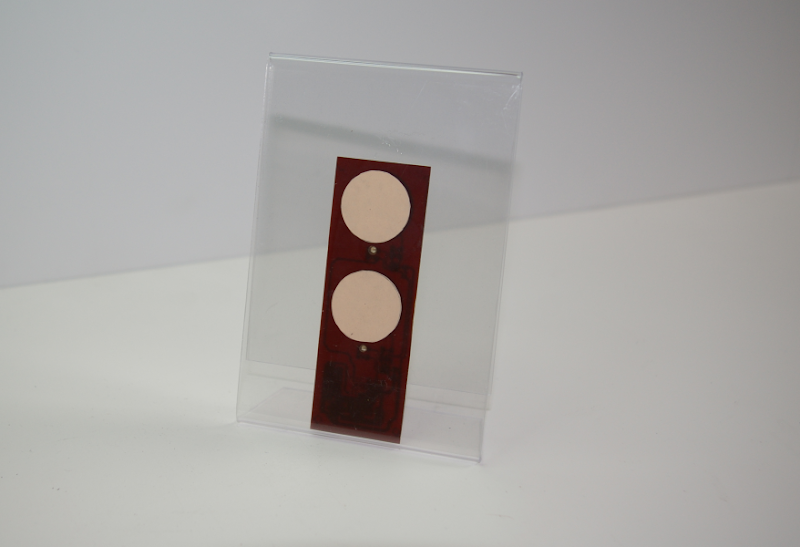The touch technology is something very common in our lives nowadays. Elevators, PDA's, cell phones, anything potentially controllable by the end user can incorporate this technology, simple to use but somehow complicated to implement.
The target of this project is to develop a capacitive touch button panel that could be mounted behind any non-conductive surface, mainly plastic and glass. This experiment aims now to produce a 5V signal when a button is touched (or almost touched) but next evolutions of this project should incorporate some kind of communication interface to report button changes to the bus. For example, the addition of a DS2406 would allow the panel to communicate with our opn-one or any other 1-Wire master.
This project came to my mind when I began thinking in the way of putting hidden buttons behind bathroom mirrors and under methacrylate tables. Installing conventional mechanical buttons often affects the aesthetics of the room so why not putting one of this panels instead?
The complexity of the touch panel has been reduced to the minimum. This version is only formed by a linear voltage regulator, two QT100A capacitive detectors, two touch keys directly built on the PCB and two LED's to give visual feedback of the key activation. I will try to post the schema once I tune a couple of capacitor values. Meanwhile, I leave here some pictures of the project and a demonstration video.
Rear view of the panel. The capacitive keys are directly built on the copper layer.
Front view of the panel. As you can see, it is a single side PCB. This side can be
Panel mounted behind a picture frame
This video shows how the panel works when mounted behind a non-conductive surface
Tuesday 30 September 2008
Batteryless magic
In the past ten years, at least a dozen of wireless technologies have appeared with the intention to cover the retrofit Home Automation market. Among them, Zigbee and Zwave seem having taken some advantages over the rest mainly due to the fact that any company can develop compatible products at relative low cost. However, even not being as popular and as broad adopted as the "Z" technologies, a German solution takes strongly my attention and makes me imagine very good successes for the next years.
EnOcean, a spin-off company from Siemens, was founded in 2001 over some unique patents that allow their wireless sensors work without batteries. At this point, I think that nobody could find any argument against the originality of such feature; wireless sensors that don't need of a human maintenance forever... The more I think about this, the more I'm sure about the success of this solution. But we technical people need to know more about how this magic works.
EnOcean, as Zwave, is the company that provides anyone wanting to develop products under the technology with the OEM RF modules and integration tools. Besides, EnOcean also sells the energy harvesters, the actual kingdom treasure. EnOcean acts then as OEM provider, promoter and owner of this technology, having created this year the enOcean Alliance formed by more than 25 companies (Siemens among them).
This technology was designed simple and easy to use. The product portfolio is formed by transceivers, receivers and transmitters. Transceivers and receivers are the most common devices; they need obviously of an external power source as they are always alert on the reception of a transmitter message. Transmitters, on the other hand, sleep most of the time and only wake up at the moment of reading values and sending data to the receivers and bidirectional transceivers. Needing much less energy to work than the receivers, EnOcean transmitters are specially designed to be powered by their patented energy harvesters. EnOcean wall switches take the necessary energy to send on/off (or up/down) commands from the mechanical action deployed onto the switch button and the scrolling of a magnetic ferrite into a coil. Temperature and humidity sensors are powered by small solar panels that can bring power even in conditions of relative darkness. EnOcean is even working in a wireless sensor that could take the power from the current generated by the Peltier effect.
But what could be limiting the adoption of the EnOcean technology? EnOcean compatible products seem having a relative success when combined with other building automation technologies as EIB, Lonworks or BacNet. Nevertheless, only the transmitters can be integrated with other technologies as only transmitters have unique addresses that make them identifiable in the network. In this case, the simplicity of this technology could be limiting the use of EnOcean's receivers in large intelligent networks. Besides, the price of the OEM modules is still expensive. Excessive price and the lack of addressing and acknowledgment at the receivers side could be somehow complicating the deployment of EnOcean wireless modules in standard home automation installations.
Some of the news coming from EnOcean could be pointing to the direction of solving some of these issues in the future. It seems that the German company could be working in a new protocol specification that would simplify the bidirectionality and addressing of receivers. Perhaps a wider use of this technology would reduce production costs and would let us users introduce this magic technology into our homes at lower prices.
Link to EnOcean website
EnOcean, a spin-off company from Siemens, was founded in 2001 over some unique patents that allow their wireless sensors work without batteries. At this point, I think that nobody could find any argument against the originality of such feature; wireless sensors that don't need of a human maintenance forever... The more I think about this, the more I'm sure about the success of this solution. But we technical people need to know more about how this magic works.
EnOcean, as Zwave, is the company that provides anyone wanting to develop products under the technology with the OEM RF modules and integration tools. Besides, EnOcean also sells the energy harvesters, the actual kingdom treasure. EnOcean acts then as OEM provider, promoter and owner of this technology, having created this year the enOcean Alliance formed by more than 25 companies (Siemens among them).
This technology was designed simple and easy to use. The product portfolio is formed by transceivers, receivers and transmitters. Transceivers and receivers are the most common devices; they need obviously of an external power source as they are always alert on the reception of a transmitter message. Transmitters, on the other hand, sleep most of the time and only wake up at the moment of reading values and sending data to the receivers and bidirectional transceivers. Needing much less energy to work than the receivers, EnOcean transmitters are specially designed to be powered by their patented energy harvesters. EnOcean wall switches take the necessary energy to send on/off (or up/down) commands from the mechanical action deployed onto the switch button and the scrolling of a magnetic ferrite into a coil. Temperature and humidity sensors are powered by small solar panels that can bring power even in conditions of relative darkness. EnOcean is even working in a wireless sensor that could take the power from the current generated by the Peltier effect.
But what could be limiting the adoption of the EnOcean technology? EnOcean compatible products seem having a relative success when combined with other building automation technologies as EIB, Lonworks or BacNet. Nevertheless, only the transmitters can be integrated with other technologies as only transmitters have unique addresses that make them identifiable in the network. In this case, the simplicity of this technology could be limiting the use of EnOcean's receivers in large intelligent networks. Besides, the price of the OEM modules is still expensive. Excessive price and the lack of addressing and acknowledgment at the receivers side could be somehow complicating the deployment of EnOcean wireless modules in standard home automation installations.
Some of the news coming from EnOcean could be pointing to the direction of solving some of these issues in the future. It seems that the German company could be working in a new protocol specification that would simplify the bidirectionality and addressing of receivers. Perhaps a wider use of this technology would reduce production costs and would let us users introduce this magic technology into our homes at lower prices.
Link to EnOcean website
Saturday 27 September 2008
Zigbee Smart Energy solutions
After being a little rough with Zigbee in the past and complaining about the lack of products compatible with the Home Automation profile, I must admit that this standard has done a lot of progresses in the Energy Management area during the last year. Whilst the big companies don't dare to release Zigbee compatible devices for the Home Automation market, other smaller companies specialized in the Energy sector are surprising us with smart solutions for saving energy and controlling our bills. It's obvious that the offer of solutions for energy management applications has traditionally been much smaller than the portfolio of technologies commercialized around the Home Automation market. This fact translates into a less exposed market, less competitiveness and a lack of primitive prejudices. We also may take into account how vertical is the Energy sector compared with the sometimes ambiguity of the Home Automation environment. Even though, nobody will be shocked if we include the energy management as a part of the home automation ecosystem. But the reality is that a dozen of companies, sponsored by utility companies in some cases, have decided to release specific products for Energy Management applications. Most of these smart energy solutions have been certified by the Zigbee alliance and claim to be strictly compatible with the Zigbee Smart Energy profile, meaning that the products are interoperable between them.
Plug-in modules measuring the energy consumed by the appliance connected to the outlet, thermostats displaying temperature and energy costs, energy meters transmitting data to a central point, are some of the offers designed under the Zigbee logo. Around this range of products, utilities, web portals and end users are offered a way to control and monitor the energy consumption (and production, of course) and saving resources in the interest of a better sustainable development.
Link to the list of Zigbee Smart Energy Certified Products
Plug-in modules measuring the energy consumed by the appliance connected to the outlet, thermostats displaying temperature and energy costs, energy meters transmitting data to a central point, are some of the offers designed under the Zigbee logo. Around this range of products, utilities, web portals and end users are offered a way to control and monitor the energy consumption (and production, of course) and saving resources in the interest of a better sustainable development.
Link to the list of Zigbee Smart Energy Certified Products
Subscribe to:
Posts (Atom)





